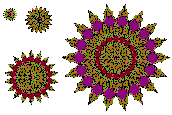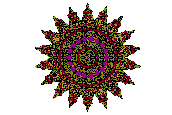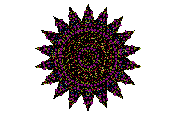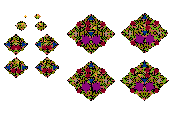18-sided polygon system
The following transform shows a set of shapes based on 20-degree angles that can be used to create an 18-sided polygon.
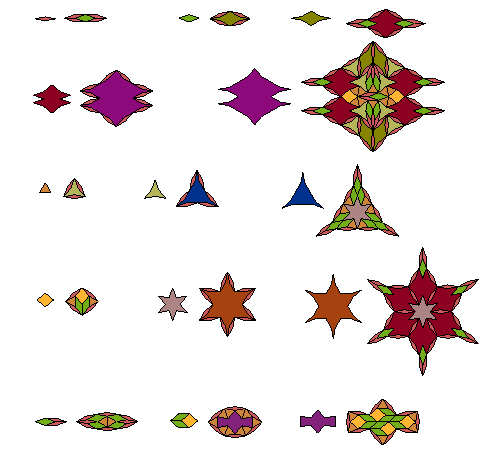
This is one possible set of pieces. It took me a while to find this, and while smaller sets may be possible, this is the smallest I could find.
The first four rows contain 11 pieces that form a complete set of pieces for transform.
However, two of the transforms are not completely symmetric. The last row contains three more shapes that allow for symmetric designs. Two of the shapes in this last row (the two hexagons) are shown broken down into other pieces, but these can really be thought of as complete pieces.
The grown pieces using this transform are shown on a separate page.
The 18-pointed star
An 18-pointed star based on these transformed pieces is shown below.
|
PDF version (68 KB) |
|
|
PDF version (202 KB) |
|
|
PDF version (693 KB) |
As designs grow, vertices in the patterns become more complex and each vertex has the 18-pointed star growing from it.
Symmetry
If only the first 11 pieces are used, then the two pieces that have symmetry problems are the grown orange fat diamond and the grown purple double saucer. The grown purple double saucer has the thin hexagon in its center. The grown orange fat diamond has the fatter hexagon in its center. The following diagram shows how the fat diamond would grow non-symmetrically.
|
PDF version (59 KB) |
This shows fat diamonds F0 to F4, with two possible F2 patterns, four possible F3 patterns, and four of eight possible F4 patterns.
The reason there are two possible F2 patterns is because the orange diamond in F1 has two possible orientations. Each orientation results in a different F2 pattern, which are reflections of each other.
The reason there are four F3 patterns is because the orange diamond in each F2 has two possible orientations. Each orientation results in a different F3 pattern. In one of the diamonds, it appears that the orange diamond keeps rotating to the right. In another, the orange diamond always rotates to the left. In the other two, it appears to alternately rotate to right and left for each iteration.
The four F4 patterns continue these patterns of always right, always left, or zig zag. These patterns are pairs of reflections, but the two pairs are very different from each other.
Since all pieces eventually grow to include orange diamonds, all pieces using the non-symmetric transform have this non-symmetry in them.
The symmetric transform, created by adding the last row of three pieces, solves this problem for the orange fat diamond and the purple double saucer.
Return to ideas for more designs.
Copyright 1998-2004 by Jim Millar
